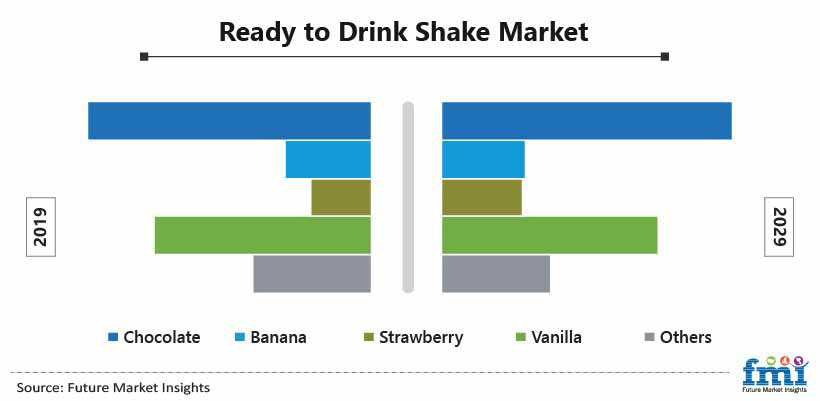The estimated revenue generated from the global ready-to-drink shakes market is US$ 9 Bn in 2019, and is projected to reach US$ 16 Bn by 2028. The market is therefore projected to rise at a CAGR of ~6% between 2020 and 2028.
Globally, functional drinks are sought after for their high protein content and their demand is likely to rise steadily over the forecast period. A key factor resulting in increasing consumption of functional drinks is the increase in the consumer spending power, especially in developing nations. Ready-to-drink shakes which constitute a category of functional drinks are available in various flavours for retail sales in the global market. Some of these flavours are chocolate, banana, strawberry, among others. The global market of ready-to-drink shakes is analyzed on the basis of various flavours. These products are available for sale in different packaging forms, like bottles, tetra packs/cartons, and cans, which offers heightened convenience. Ready-to-drink shakes are meeting the current health and wellness demand in such a way that the drinks offer high protein amount with added specialty health ingredients.

Request a report sample to obtain authentic analysis and comprehensive market insights at @ https://www.futuremarketinsights.com/reports/sample/rep-gb-11120
Key Takeaways from the Ready to Drink Shake Market Study
- Obesity is one of the strong issues faced by countries such as the U.S., Canada, Australia, U.K., etc. Ready-to-drink shakes are consumed as a meal replacement to achieve the weight management by restricting the calorie intake.
- Due to the increased prevalence of the diseases and subsequently rising trend of health and wellness, ready-to-drink shakes market is expected to witness positive growth over the forecast period.
- Ready-to-drink shakes are being increasingly opted by fitness enthusiasts and athletes, since it allows avoiding the hassle of the mixing of protein powder in the liquid of choice and also the wait.
- Although, ready-to-drink shakes promise excellent results for gym goers and fitness enthusiasts, the product is still in the introductory phase in developing economies and economies are in transition stage. Therefore, because of the premium nature of the product and its expensive price, the market penetration may get hindered in emerging countries.
“Ready-to-drink shakes market is expected to channel upwards due to the excellent marketing strategies of the key players in the global market, resulting in the positive growth in the emerging markets,” says the FMI analyst.
Easy Availability and Increasing Penetration of Manufacturers and Sellers of Ready-to-Drink Shakes to Positively Impact Growth
Due to the increase in the preference for e-commerce platforms for transaction and shopping, the market reach out of the ready-to-drink shakes is anticipated to increase in the developed and developing economies. The boom in the IT sector has led to the development of the various new and easy ways of the transactions and shopping across various domains. The food and beverage industry is also driven by the increased use of the e-commerce platforms, since consumers have top priority for convenience and ease of doing business. Likewise, e-commerce platforms have enthralled the potential buyers of ready-to-drink shakes due to the easy and increased availability of the products, even in remote areas. Ready-to-drink shakes sales across e-commerce platforms are anticipated to rise over the forecast period and likely to be one of the drivers of the market growth.
Who is winning?
Some of the key players operating in the Ready to Drink Shake market are Nestlé S.A, Starbucks Corporation, PepsiCo Inc., Monster beverage Co., Lotte Chilsung Beverage Co., The Coca-Cola Company, The J.M Smucker Company, Bolthouse Farms, Inc., Arla Foods amba, Atkin Nutritionals Inc. and others.
- In 2017, Nestlé acquired an Oakland-based coffee roaster and retailer, ‘Blue Bottle Coffee, Inc.’, to expand its market in the region.
- In 2017, Nestlé expanded its ready to drink product range in Asia Pacific, majorly in India, Thailand, and Nigeria, by offering healthy on the go beverages for younger people, which included sugar reduced Nesquik and Milo Activ Go.
Get Valuable Insights into Ready to Drink Shake Market
Future Market Insights, in its new offering, brings to fore an unbiased analysis of the global ready-to-drink shakes market, presenting historical demand data (2014-2018) and forecast statistics for the period 2019-2028. The study divulges compelling insights on the ready-to-drink shakes market on the basis of nature (organic and conventional), packaging type (bottles, tetra packs/carton, and cans), flavour (chocolate, banana, strawberry, vanilla, and others), and distribution channel (supermarket/hypermarket, online retail, specialty stores, convenience stores, and other retail format) across six major regions.
READY TO DRINK SHAKE MARKET STRUCTURE ANALYSIS
- The ready to drink shake market is characterized by a handful of global and regional players.
- Product innovation and new launches remain crucial focus areas of these market players.
- Capitalization on omni-channels and social medial platforms for product awareness will be a key to gaining competitive edge.
- Inorganic growth strategies including R&D investments and M&A activities are also adopted by leading market players.
- Base year considered – 2019
- Actual estimates/Historical data – 2014 – 2018
- Forecast period – 2019 – 2028
- Market Value in 2019 – US$ 9 Bn
- Segments covered – Nature, Packaging, Flavor, Distribution Channel
Ask an Analyst @ https://www.futuremarketinsights.com/askus/rep-gb-11120
READY TO DRINK SHAKE MARKET TAXONOMY
The global ready to drink shake market is segmented in detail to cover every aspect of the market and present complete market intelligence to readers.
Nature
- Organic
- Conventional
Packaging Type
- Bottles
- Tetra Packs/ Carton
- Cans
Flavour
- Chocolate
- Banana
- Strawberry
- Vanilla
- Others
Distribution Channel
- Supermarket/Hypermarket
- Online Retail
- Specialty Stores
- Convenience Stores
- Other Retail Formats
Region
- North America
- Latin America
- Europe
- APEJ
- Japan
- Middle East & Africa
